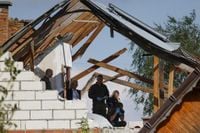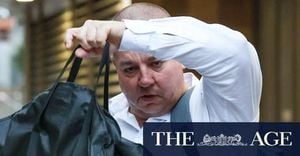On September 10, 2025, the skies above eastern Poland erupted into an unexpected theater of international tension. Seventeen Russian-made drones crossed into Polish airspace, some crashing into the countryside near Lublin and damaging roofs, but miraculously causing no injuries. For Poland, this was not just another border incident—it was a stark test of NATO’s resolve, and a direct challenge to the security of the alliance’s eastern flank, according to multiple European officials and confirmed by Reuters and Newsweek.
Polish and allied NATO fighter jets, including Dutch aircraft, scrambled in response, intercepting and reportedly shooting down several of the drones. It marked the first time since Russia’s full-scale invasion of Ukraine in February 2022 that a NATO member had directly engaged Russian aerial assets in its own airspace. The sense of alarm was palpable across Europe. As Polish Prime Minister Donald Tusk put it on September 12 in a message on X, “We would also wish that the drone attack on Poland was a mistake. But it wasn’t. And we know it.”
The incident quickly spiraled into a diplomatic standoff, with Poland’s leadership unequivocally rejecting any notion that the drone incursion was accidental. President Karol Nawrocki, speaking to soldiers and the public, called the event “nothing more than an attempt to test our capabilities and response. It was an attempt to test the mechanisms of action within NATO and our ability to respond.” Polish Foreign Minister Radoslaw Sikorski echoed this sentiment, posting, “No, that wasn’t a mistake.” Deputy Minister of Defense Cezary Tomczyk was even more blunt, telling Polsat News: “There’s no question of a mistake—this was a deliberate Russian attack.”
Despite the unified front from Warsaw, former U.S. President Donald Trump offered a contrasting perspective. When pressed by reporters at the White House on September 11, Trump suggested, “It could have been a mistake.” He later added, “I don’t like it, I’m not happy about it. The whole thing, I’m not happy about. But hopefully it’s going to come to an end.” On his social platform, Truth Social, Trump had earlier written, “What’s with Russia violating Poland’s airspace with drones? Here we go!”
Trump’s remarks drew swift rebukes from Polish officials, who saw them as giving undue credence to Moscow’s narrative. For Warsaw to so directly contradict a U.S. president—especially one who has previously praised Poland’s defense spending and called for greater European military contributions—was almost unheard of. According to Reuters, this rare public disagreement underscored the depth of Europe’s alarm at what they saw as Trump’s willingness to entertain Russian explanations.
Russia, for its part, denied any intention to strike Polish territory, claiming its forces were targeting Ukraine at the time. The Russian government’s newspaper Rossiyskaya Gazeta dismissed the Polish reaction as “demonization” and accused the West of “provocation” and escalating the conflict for its own ends. Kremlin spokesman Dmitry Peskov insisted peace negotiations were “on pause” and blamed European countries for hindering the process.
But for Poland and much of Europe, the incident was a wake-up call. The Polish government swiftly invoked NATO’s Article 4, formally starting consultations with its allies on how to respond. Germany, in a show of solidarity, extended its air policing mission over Poland, with a defense ministry spokesperson confirming that “aviation already established operational readiness yesterday evening,” ensuring two 24/7 alarm rotas were now in place. France pledged to deploy three Rafale fighter jets to help protect Polish airspace, while both Germany and France summoned Russian ambassadors to protest the incursion. Other European nations, including the Netherlands and Spain, followed suit.
The United Nations Security Council convened on September 12 at Poland’s request to discuss the drone incursion—a move that highlighted the seriousness with which Warsaw and its allies viewed the breach. NATO also called a press conference the same day, with Secretary General Mark Rutte and Supreme Allied Commander Europe Alexus Grynkewich addressing the alliance’s response and the broader implications for European security.
The drone incident unfolded as Russia and its close ally Belarus began a long-planned joint military exercise, with drills taking place in both countries and in the Baltic and Barents seas. This show of force, coupled with continued Russian attacks on Ukraine—including deadly strikes in the Sumy region and Ukrainian drone attacks on Russian oil infrastructure—underscored the volatility of the region. Meanwhile, Ukraine reported finding more Russian and Belarusian-made components in Iskander missiles, signaling a shift away from Western electronics due to sanctions, as noted by Ukrainian officials to Reuters.
Within the European Union, the response was multi-faceted. EU member states agreed to extend sanctions on Russian individuals and companies for another six months, maintaining pressure on Moscow. Denmark’s foreign minister, Lars Løkke Rasmussen, called for the next sanctions package to be “as tough as possible,” emphasizing the need for stronger transatlantic cooperation. The U.S. Treasury urged G7 and EU allies to impose “meaningful tariffs” on goods from China and India to curb their purchases of Russian oil, convening an emergency finance meeting to ratchet up economic pressure on the Kremlin.
Yet, not all voices in Europe were unified in their analysis. Some questioned whether the incursion was a deliberate Russian attack or a byproduct of the chaotic conflict in Ukraine. Still, the overwhelming consensus among Polish and European officials was that Moscow’s actions were a calculated test of NATO’s defenses and unity. As Prime Minister Tusk stood before Polish Air Force F-16s at the 32nd Tactical Air Base, his message was clear: Poland would not be cowed, and neither should NATO.
Back in Washington, European officials sought to coordinate further sanctions with the U.S. administration, though joint announcements—once routine—had become less frequent since Trump’s return to office. The situation exposed cracks in allied coordination, but also reinforced the critical importance of transatlantic solidarity in the face of renewed Russian aggression.
As the dust settled over Poland’s fields, the world watched closely. The incident had rattled nerves, tested alliances, and forced leaders to confront the real and present dangers of a war that, for now, shows no sign of abating.





